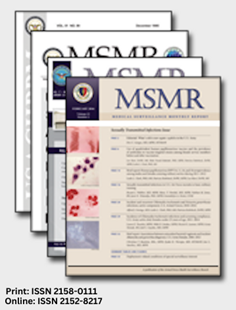Skip subpage navigation
 The Medical Surveillance Monthly Report, published continually since 1995, is a peer-reviewed journal of the Armed Forces Health Surveillance Division. The MSMR publishes monthly reports describing the incidence, distribution, impact, or trends of illness and injuries among members of the United States Armed Forces and other beneficiaries of the Military Health System. The most widely read issue each year focuses on the annual absolute and relative morbidity burden attributable to various illness and injuries among service members and beneficiaries, which appeared in two issues in 2023, Issue 6 and Issue 7.
The Medical Surveillance Monthly Report, published continually since 1995, is a peer-reviewed journal of the Armed Forces Health Surveillance Division. The MSMR publishes monthly reports describing the incidence, distribution, impact, or trends of illness and injuries among members of the United States Armed Forces and other beneficiaries of the Military Health System. The most widely read issue each year focuses on the annual absolute and relative morbidity burden attributable to various illness and injuries among service members and beneficiaries, which appeared in two issues in 2023, Issue 6 and Issue 7.
Articles from each issue of the MSMR are accessed by scrolling to the You Also May Be Interested In... section of this page. A printable PDF of the most recent issue of the MSMR can be downloaded here.
The MSMR is always seeking high quality, relevant submissions for publication. Prospective authors are welcome to review instructions and submit manuscripts within the aims and scope of the journal. Inquiries regarding content or material to be considered for publication should be directed to the MSMR Editor.
Here, you can download the current and past issues of the MSMR. Inquiries regarding content or material to be considered for publication should be directed to the MSMR Editor.
Citing the MSMR
When citing MSMR articles, please use the following formats:
Author Names Listed with the Article
Collier DA, Bayles MK, Barrett, JP. Acute gastroenteritis outbreak at the Armed Forces Retirement Home, Washington, DC, January 2011. MSMR. 2011;18(6):11-14.
No Author Name Listed (April 2007 to current)
Armed Forces Health Surveillance Branch. Mental disorders and mental health problems, active component, U.S. Armed Forces, January 2000 – December 2009. MSMR. 2010;17(11):6-13.
No Author Name Listed (Before April 2007)
Army Medical Surveillance Activity. Overhydration and hyponatremia among active-duty soldiers, 1997-1999. MSMR. 2000;6(3):9-11.
You also may be interested in...
Article
Nov 1, 2023
Reportable Medical Events are documented in the Disease Reporting System internet by health care providers and public health officials throughout the MHS.
Article
Nov 1, 2023
Common respiratory viruses are associated with substantial morbidity within the MHS.
Article
Nov 1, 2023
Continuous surveillance is essential to prevent cold weather injuries and mitigate their adverse impacts on military operations.
Article
Nov 1, 2023
This report describes recent frequencies and rates of clinically-diagnosed sunburn among active component service members of the U.S. Armed Forces.
Article
Nov 1, 2023
The U.S. Advisory Committee on Immunization Practices recommends influenza vaccination for all health care personnel, including MHS staff, to protect both themselves and their patients.
Report
Nov 1, 2023
 .PDF |
1.07 MB
.PDF |
1.07 MB
MSMR November 2023 volume 30 issue 11
Article
Oct 1, 2023
Complete and timely reporting of notifiable medical conditions among the Department of Defense (DOD) beneficiary population is important for the control of communicable and preventable diseases and injuries.
Article
Oct 1, 2023
Reportable Medical Events are documented in the Disease Reporting System internet by health care providers and public health officials throughout the Military Health System.
Article
Oct 1, 2023
This report describes the incidence rate of colorectal cancer among active component U.S. military service members between 2010 and 2022.
Article
Oct 1, 2023
The emergence of mutant P. falciparum parasites in many malaria-endemic areas has led to false-negative results in all HRP2-detecting rapid diagnostic tests, undermining their critical utility, especially in deployment settings.
Report
Oct 1, 2023
 .PDF |
1.29 MB
.PDF |
1.29 MB
The October 2023 Medical Surveillance Monthly Report (MSMR) provides a review of the incidence of colorectal cancer among active component service members from 2010 to 2022; followed by a study of force protection risks in AFRICOM, INDOPACOM, and SOUTHCOM due to rapid diagnostic test failures for P. falciparum malaria from 2016 to 2022; then an update ...
Article
Sep 1, 2023
This report provides an update through June 2023 of routine screening results for antibodies to HIV among members of the U.S. military. From January 2018 through June 2023, approximately 7 million U.S. military service members (active component, reserve component, and national guard) were tested for HIV antibodies; 1,502 were identified as HIV ...
Article
Sep 1, 2023
Reportable Medical Events are documented in the Disease Reporting System internet by Military Health System providers and public health officials to monitor, control, and prevent the occurrence and spread of diseases of public health interest or readiness importance.
Article
Sep 1, 2023
This Surveillance Snapshot presents the incidence of the 10 leading cancers among active component service members of the U.S. Armed Forces diagnosed from January 2018 through December 2022.
Article
Sep 1, 2023
This is the first known study examining the rates of seropositivity for Ross River virus in a naïve U.S. Military population prior to an outbreak event, which identified a single seroconversion out of 628 deployed U.S. servcie members tested.
You are leaving Health.mil
The appearance of hyperlinks does not constitute endorsement by the Department of Defense of non-U.S. Government sites or the information, products, or services contained therein. Although the Defense Health Agency may or may not use these sites as additional distribution channels for Department of Defense information, it does not exercise editorial control over all of the information that you may find at these locations. Such links are provided consistent with the stated purpose of this website.
You are leaving Health.mil
View the external links disclaimer.
Last Updated: April 08, 2024